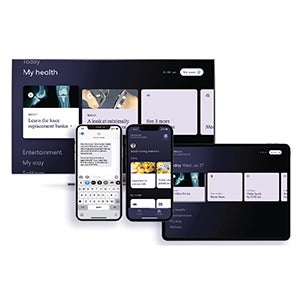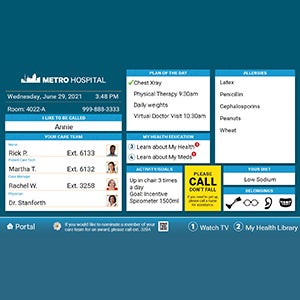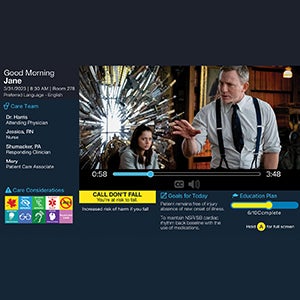Patient engagement technology advances

Image courtesy of PDi Communication Systems Inc.
In recent years, patient education and entertainment systems have evolved into patient engagement systems. They incorporate a wide range of media such as digital whiteboards and interactive TVs, which can improve the patient experience.
Many systems are designed to give patients health information, education and entertainment in a language they can understand. The growth of technologies such as hand-held devices, Internet of Things (IoT) and artificial intelligence (AI) has accelerated the development of these systems as well.
However, hospitals pose some difficulties for vendors. Lack of appropriate infrastructure is an issue, and many hospitals need to upgrade TVs, cabling and hardware. Also, many electronic health records (EHRs) do not support integration. All of these factors can add up in cost.
Due to constrained budgets and low staffing levels post-pandemic, limited funds are available to invest in patient engagement systems, manufacturers say.
Hospital challenges
One of the top challenges hospitals face today is nurse staffing, says Jeff Fallon, chairman and CEO of eVideon, Grand Rapids, Mich. “Recent innovations in patient engagement platforms help reduce the burden on nurses, ridding them of nonclinical tasks and providing them with access to mission-critical data at the point of care,” he says. “Enabling the care team to practice at the top of their license is not just an essential management strategy; it’s a proven driver of improved patient outcomes.”
Another issue is increased demand for better consumer entertainment services in patient rooms. Patients want TVs with advanced streaming and entertainment functions, just like the ones they have at home. However, the hospital market presents hurdles that make streaming platforms difficult to add. “We foresee a future where consumer streaming apps and functions will be integrated into the hospital portfolio, but we still have a long way to go until that is the norm,” says Tom Mottlau, health care director at LG Business Solutions USA, Lincolnshire, Ill.
Hand-held devices, IoT and AI will continue to impact the development of patient engagement systems, according to Todd Strickler, senior vice president of product at Get Well, Bethesda, Md. “As IoT expands beyond high-value medical assets onto beds, patients and caregivers, new technology will enable more automated workflows, announcing room arrivals and departures, as well as alerting when patients are up and about,” he says. “It’s still early for these emerging technologies, but we expect hand-held devices, IoT and AI to become ubiquitous within hospital systems in the next two to three years.”
IoT allows the aggregation of data from disparate devices to produce valuable information for different patient engagement purposes, according to Alex Yashkevich, head of portfolio for the health care vertical market at Siemens Smart Infrastructure USA, Buffalo Grove, Ill. “Developers of patient engagement systems are already looking into designing future platforms with IoT device interoperability in mind,” he says.
Facilitating connections
Many patient engagement systems recently introduced to the health care market offer features that facilitate connection between patients, family and hospital staff. What’s more, digital displays are evolving in a big way.
LG Business Solutions has introduced the Patient Engagement Board, a digital display that meets patient demands while providing a secure, standardized platform that ensures records are not lost. The 32- and 43-inch patient engagement boards are UL-listed for patient room use. The 32-inch model is equipped with Power over Ethernet, which allows for easy installation. “Given that these 32-inch displays are smaller and don’t accommodate screen splitting, they are most efficient when coupled with standard in-room hospital TVs,” Mottlau says.
When paired with a patient engagement board, LG’s new 75-inch NanoCell Hospital TV delivers added benefits, Mottlau adds. The 75-inch digital display offers split-screen capabilities so patients can display their medical information on one side and entertainment on the other.
LG also has developed the Smart Cam Pro, a 12-megapixel camera accessory designed to mount to the top of an LG hospital TV. It incorporates 4x digital zoom and a directional, four-microphone array to enable virtual physician visits with patients. The company also offers a modular video camera that attaches to its 15-inch Personal Healthcare Smart Touch TV and supports high-definition video communication. It can be installed on an adjustable arm for use in shared spaces or smaller patient rooms.
Many new systems are customized. MDM Healthcare, Ponte Vedra Beach, Fla., offers the Journey PX patient engagement platform, which combines high-touch and high-tech to address complex communication challenges in health care, according to Linda Robinson, R.N., CPXP, vice president of clinical excellence. “We work closely with hospitals to design training and utilization strategies around evidenced-based practices that are proven drivers of quality and safety such as bedside shift reports and hourly rounding,” she says. “This includes engaging cues, pop-ups and prompts that empower patients to participate in their care in a meaningful way.”
More than 50% of patient engagement today is done on personal devices, and that number is higher with the 50 and younger age demographic. So, having a system that is tied to a bedside terminal and can be accessed via a local webpage on the local Wi-Fi is important, according to Robin Veinotte, director of new business ventures for SolutionInc, Halifax, Canada.
To that end, SolutionInc offers patented gateway solutions for network access to Wi-Fi, local TV streams and patient services so that patients can have a positive experience on the screen attached to the wall, but also on their tablet, phone or laptop. “Having a system that works for self-serve (i.e., bring your own device) and direct-serve (i.e., hospital-supplied bedside terminal) is critical,” Veinotte adds.
Get Well recently upgraded its patient engagement systems for the health care market. “For patients using their own devices in hospitals, we’ve added mobile modes to accommodate their smartphone usage — whether by text, web or mobile app — to utilize all the features of our inpatient solutions,” Strickler says. “We’ve upgraded our systems to achieve industry certifications for data security, including certificates for the government, which helps health care organizations utilize the cloud safely and securely.”
Get Well also has extended digital experiences upstream with patient outreach and communications capabilities before admission and post-discharge, enabling seamless patient journeys both in and out of the hospital.
eVideon has introduced the Engage TV solution, which serves as a central interface in the patient room for education, entertainment and engagement. Through its integration with EHR, nurses can automate the process of education assignment and documentation. Educational videos, based on a patient’s treatment plan, can be sent directly to the patient’s TV, with completion of those videos automatically documented back in the EHR. In addition, Engage TV can be integrated with in-room cameras to enable virtual nursing and telehealth visits, without the need to bring extra equipment into the room.
eVideon also offers the Insight Digital Whiteboard, a communications tool that provides real-time information to clinical teams. Another patient engagement solution is the Aware Digital Door Sign. Both systems integrate with the hospital’s EHR. “The Aware Digital Door Sign helps hospitals enforce safety measures that protect staff, patients and visitors; it also helps facilitate care team coordination,” Fallon says.
pCare, Lake Success, N.Y., offers the Interactive Patient Care System platform, which includes VideoConnect, Digital Whiteboard and Room Connect digital door signs. VideoConnect allows patients to video chat with family and friends outside the hospital, connect remote language interpreters with a single click and help clinicians conduct virtual rounds from any location; Digital Whiteboard includes integrations with the EHR and other health information technology systems that provide up-to-date information for patients, families and clinicians; and pCare’s Room Connect digital door signs provide information to staff upon entry into the patient room.
“A host of empowerment features allow patients to manage nonclinical tasks associated with an admission,” says Tim Vaughan, chief product officer at pCare. “This can include meal ordering, placing a service request for room cleaning or a chaplain visit, or changing the lighting or temperature in a room. In terms of IoT, our open platform provides flexibility to integrate solutions as they are deployed in the hospital. Right now, we tie into real time location systems (RTLSs) to digitally announce staff to the patient and family. So, when a team member enters a patient room, their picture, name and title appear on the TV and whiteboard.”
Use of cloud technology is another innovation. PDi Communication Systems Inc., Springboro, Ohio, offers the GENiO cloud-based patient engagement platform, “Because GENiO uses cloud technology, hospitals incur no on-site server or admissions, discharge and transfer expenses,” says Glen Rocco, director of business development at PDi. “GENiO allows staff to manage apps, troubleshoot TVs and deliver messages to patients, all from their office or nursing station.”
Additionally, GENiO provides a wide range of entertainment and information options to better engage patients. These include TV and streaming services, games, music, patient education videos and telehealth services. GENiO content can be tailored to patient preferences and needs. For instance, hospitals can deliver educational videos about chemotherapy to cancer patients or provide YouTube Kids videos for the children’s unit.
Symtech Solutions, Ivyland, Pa., offers digital whiteboards that facilitate patient engagement and entertainment as well as staff workflow and family engagement. Each device is customized to a hospital’s needs. “The digital whiteboard solution was built on a platform to be vendor-agnostic,” says Zach Jakuboski, senior product specialist at Symtech. “This allows the whiteboards to integrate with existing systems such as nurse call, RTLS, vital monitors and patient education systems so that more features and information can be accessed in one place. We integrate with the hospital’s EHR to populate patient information automatically on the whiteboards upon admission. This saves the care team time and keeps information up to date.”
Siemens’ open building management platform integrates with most patient engagement systems, using secure communication protocols and interfaces, according to Yashkevich. This allows hospitals to leverage the established building infrastructure, add new technology and deliver room controls to the patient’s fingertips. “For example, pillow speakers are commonly used in hospitals,” Yashkevich says. “These hard-wired, button-based remote devices provide multifunctional control of nurse call, TV and other systems in the room. The integration between the Siemens building automation system and pillow speakers allows patients to easily control room temperature, lighting and shades.”
An interactive system can take patient engagement to the next level, Yashkevich adds. “By using a tablet or TV as the interface, the patient can call a nurse or control the room environment. They also can receive key information such as medication schedules and meal menus. Recent technology developments even allow control of the patient’s environment via voice commands.”
Advances ahead
Strickler predicts the continued evolution of dedicated clinical digital displays: digital whiteboards and room signs working in concert with patient TVs that improve care delivery and provide up-to-date patient information that saves time and improves hospital operations.
Vaughan foresees advances that will expand the reach of patient engagement systems to informal caregivers — friends and family of patients — in a meaningful way. He also sees the development of more tools and resources to support hospital caregivers.

SMART SATISFACTION
Smart hospital wall TVs and arm TVs deliver comfortable information that satisfies patients of all ages. PDi Communication Systems Inc.

COMBINED COMMUNICATION
Inpatient combines multimodal interactive patient care with omnichannel entertainment, education and clinical updates. Get Well

EDUCATIONAL TELEVISION
IPS uses the in-room TV to provide education and nonclinical controls to patients via an easy-to-use bedside pillow speaker remote control. pCare

BRIDGING THE GAP
Journey PX My Day Today is a digital whiteboard solution that helps close the communication gap between care teams and patients. MDM Healthcare

SECURE COMMUNICATION
Gateway solutions allow patients to connect to Wi-Fi and patient services while keeping staff and infrastructure networks separate and secure. SolutionInc

PERFECT PAIR
Vibe Health Engage TV and Insight Digital Whiteboard pair to share real-time health information with patients, families and care teams. eVideon

SIGNS OF THE TIMES
Digital whiteboards facilitate patient engagement and entertainment as well as staff workflow and family engagement. Symtech Solutions

CONTROLLED ENVIRONMENT
The integration between a building automation system and pillow speakers gives patients the ability to control their room environment. Siemens Smart Infrastructure USA

ALL IN ONE
The 75-inch LG NanoCell Hospital TV offers split-screen capabilities so patients can view their medical information on one side and entertainment on the other. LG Business Solutions USA
Neal Lorenzi is a Mundelein, Ill.-based contributor to Health Facilities Management.




